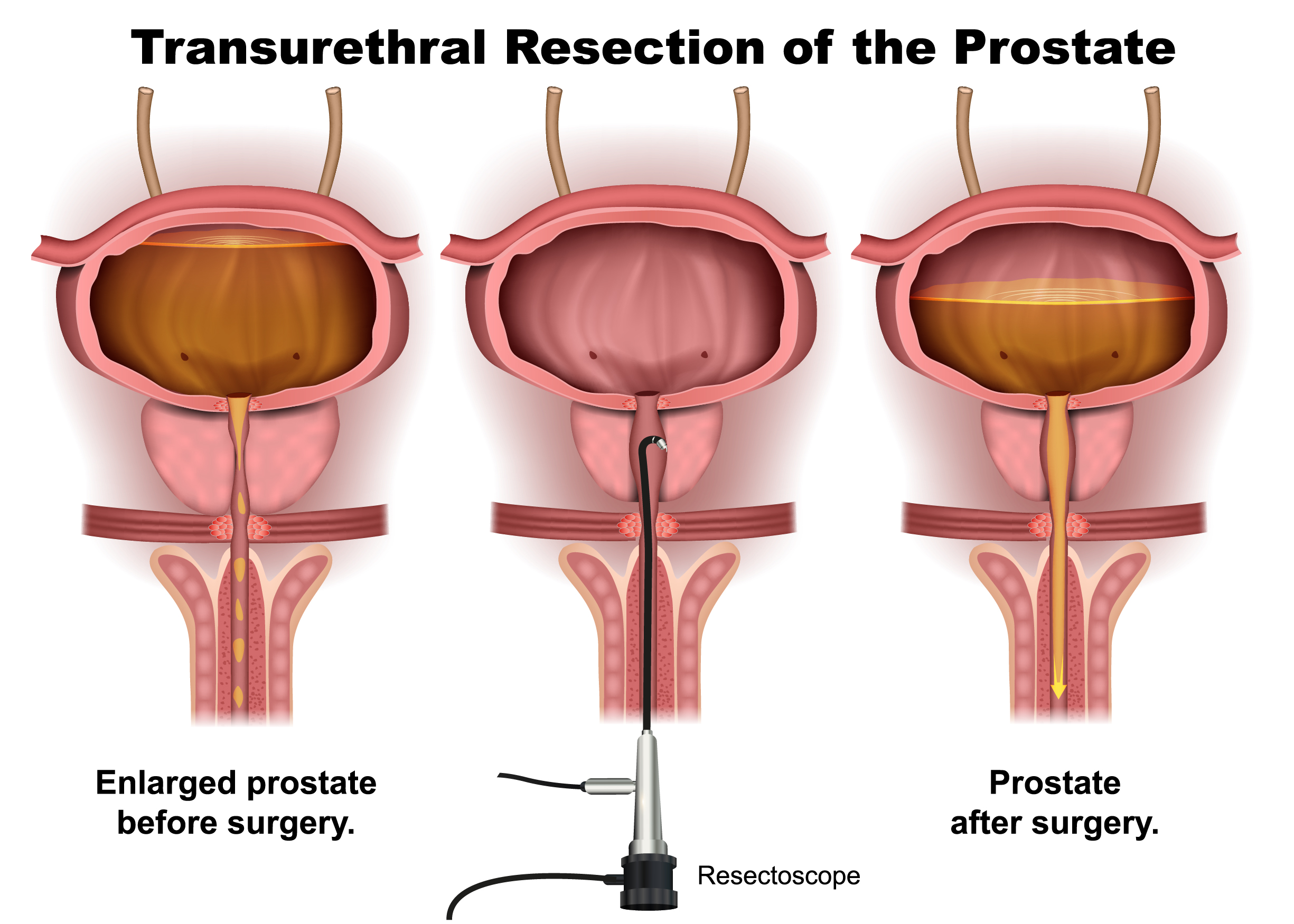Medical Management of BPH
Surgeries & Therapies for BPH
Transurethral resection of the prostate (TURP)
A transurethral resection of the prostate (TURP) is a surgical procedure that involves cutting away a section of the inner prostate to reverse a prostate-mediated blockage in the urinary tract. The prostate is a small gland in the pelvis only found in men. It’s located between the penis and bladder and surrounds the urethra (the tube that carries urine from the bladder to the penis). A specialized instrument is inserted carefully through the tip of your penis and excess prostate tissue along anatomic planes is trimmed away allowing better urine flow through the prostate.
A TURP is a great option for men who have moderate to severe urinary problems, as well as those who haven’t responded to medication. A TURP may be performed for men who have symptoms of BPH such as frequent, urgency, difficulty starting urination, urinating too frequently at night and incomplete emptying of the bladder. In more severe cases, a TURP has an absolute indication for cases of recurrent urinary tract infections, kidney or bladder damage related to bladder outlet obstruction, an inability to urinate at all (complete urinary retention secondary to BPH), bladder stones, and severe prostate related bleeding.

Risks of a TURP are very rare, and patients almost uniformly do very well. The side effects possible are as follows:
- Difficulty urinating after the procedure- It might take some days for the swelling to recede and a catheter might be needed to allow your body to recover and empty its urine temporarily.
- Urinary tract infection
- Dry orgasm. A common and long-term effect of any type of prostate surgery is retrograde ejaculation: the release of semen during ejaculation into the bladder rather than out of the penis. This is not harmful, nor should it be confused with the normal ability to have an erection, experience pleasure, and have an orgasm, all of which are not changed.
- Erectile dysfunction. The risk is minute, but can occur after prostate surgery.
- Heavy bleeding. Very rarely, men lose enough blood during TURP to require a blood transfusion.
- Difficulty holding urine. Loss of bladder control (incontinence) is a long-term complication of TURP, which is very unlikely unless the urinary sphincter, which is NOT perturbed during the procedure, is weak from conditions such as diabetes or Parkinson’s.
- Low sodium in the blood. This is a rare side effect due to the reabsorption of fluid through the prostate during surgery. Your surgeon and anesthesiologist are always on the look out for this, and if this occurs, it is immediately corrected.
- Need for repeat surgery on prostate or bladder neck due to scarring. Some men require follow-up treatment because of a narrowing that occurs called a bladder neck stricture.
You’ll likely stay in the hospital for one to two days, with a urinary catheter in place to rinse the bladder out with sterile saline. Blood in the urine is normal, as are some mild irritative symptoms. You will be required to drink plenty of water, ensure your bowel movements are frequent and soft to prevent pressure build-up around the prostate, walk around regularly to prevent blood clots in your legs, Hold off on sexual activity for 3-4 weeks. If you notice any fever or excessive bleeding, you will be required to return to the emergency room for assessment.
Laser prostate surgery – Urolift
The least invasive procedure offered is the UroLift procedure, in which tiny implants to lift and hold the enlarged prostate tissue out of the way are implanted in the prostate so it no longer blocks the urethra. There is no cutting, heating or removal of prostate tissue.
REZUM (TM) (transurethral minmally invaisve prostate thermotherapy)
While TURP has been considered the most effective treatment for an enlarged prostate, a number of other, minimally invasive procedures are becoming more effective. These procedures generally cause fewer complications and have a quicker recovery period than TURP. One of the procedures with excellent results is REZUM (TM) (transurethral minimally invasive prostate thermotherapy).
In this procedure, a specialized instrument is inserted into the penis and steam is injected into the tissue of the prostate that has grown out of proportion. With time, this steam allows your body to naturally remove this excess tissue thereby opening the prostate up to allow very good passage of urine. This procedure has advantages of being a day procedure without requiring admission, it preserves ejaculation, and has no bleeding. It is extremely effective for moderate to large prostate and can be performed in patients who cannot stop blood thinning medication.
Dr. Feifer offers a minimally invasive alternative to manage prostate obstruction, called Rezum thermotherapy. This treatment does not require a general anesthetic, is outpatient, with a quick recovery, and shows excellent immediate and intermediate term results. Please see the following link for more information and contact our office should you be interested.
Please see the following site for more information:
TREATMENTS & CONDITIONS
Benign Prostate Gland Enlargement (BPH)
Benign prostatic hyperplasia (BPH), also called prostate gland enlargement, is a common age associated condition. An

Surgery, Medical Management of BPH
When BPH needs to be treated, the first thing that is trying is a modification of lifestyle factors. There may be food

Upper Tract Transitional Cell Carcinoma
Upper tract transitional cell carcinoma is a cancer that is derived from the lining of the inside of the kidney. It is different than kidney

Surgery for Kidney Cancer
Surgery for kidney cancer can be personalized to the anatomy of the kidney and the location of the tumor. Often, only the tumor and a healthy rim of normal tissue can be removed,



